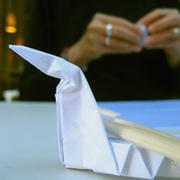DELAY: MAKE SPACE WITH THE "SPACE TECHNIQUE"
Simply put, while you're preparing to quit practice putting some "space" -- that is, time -- between each trigger and smoking. This helps your brain react less to the connections it's made in the past between having a cigarette and the trigger.
In other words, the Space Technique will make it easier to quit.
Here's an example of how it works:
Let's say your Pack Track confirms that you smoke first thing in the morning, right after you get out of bed.
Tomorrow, get out of bed, wash your face and brush your teeth before having that first cigarette.
The day after tomorrow, get out of bed, wash your face, brush your teeth, brew your coffee or tea and step outside for some fresh air before your first cigarette.
The day after that, keep up your new routine -- wash face, brush teeth, brew coffee/tea, step outside -- and add to it: Go for a short walk, make a phone call or read the newspaper (or scan the headlines online) before you smoke.
We're not saying it's going to be easy. You'll feel the urge to smoke, and that urge might be strong. But the Space Technique helps you resist the urge and, over time, lessen it.
Think about your personal triggers and the Space Technique. Take each trigger one by one and think of all the ways you can put space between it and the cigarette.
DISTRACT: TIME TO GET BUSY
In the face of triggers and cravings, keeping your mind, mouth and hands busy will help you ride them out.
Busy hands
 Keep a paper clip in your pocket that you can bend and unbend. In bars and restaurants, you can fold and unfold a napkin or drinking straw wrapper. Hold a pen in your hand. Tip the saltshaker and draw in the crystals on table. Sound a little strange? Maybe. (Okay, yes.) And you may get some puzzled looks from your dining companions, but… who cares? Download games and apps to your phone. These will help keep your mind occupied in addition to your hands.
Keep a paper clip in your pocket that you can bend and unbend. In bars and restaurants, you can fold and unfold a napkin or drinking straw wrapper. Hold a pen in your hand. Tip the saltshaker and draw in the crystals on table. Sound a little strange? Maybe. (Okay, yes.) And you may get some puzzled looks from your dining companions, but… who cares? Download games and apps to your phone. These will help keep your mind occupied in addition to your hands.
Busy mouth
Call a friend to chat; chew gum; suck on sugarless candy, a lollipop or a popsicle. Eat healthy snacks, such as celery and carrot sticks or a handful of small pretzels. Stock up on low-sodium (and low calorie) vegetable juices such as V8 or diet sodas and no-calorie juice drinks.
Busy mind
 Mentally write tomorrow's to-do list or your grocery list. Always keep a book or e-reader with you. Imagine your favorite travel destination in great detail -- the color of the sand and water, the leaves on the trees, the features of the hotel room. Picture the smiles on the faces of your partner, your friends, your kids and how happy and proud they'll be when you tell them you've quit. Indulge in a hobby -- work in the garden, pick up a paintbrush, write, plan a weekend getaway, do yoga, dance. Or catch up on chores -- vacuum, clean out that coat closet, dust.
Mentally write tomorrow's to-do list or your grocery list. Always keep a book or e-reader with you. Imagine your favorite travel destination in great detail -- the color of the sand and water, the leaves on the trees, the features of the hotel room. Picture the smiles on the faces of your partner, your friends, your kids and how happy and proud they'll be when you tell them you've quit. Indulge in a hobby -- work in the garden, pick up a paintbrush, write, plan a weekend getaway, do yoga, dance. Or catch up on chores -- vacuum, clean out that coat closet, dust.
Is your craving triggered by a particular problem or worry? Think about other ways to address or resolve it besides having a smoke. Really, in practical terms, what will smoking help you accomplish? (Nothing.)
Think about your personal smoking triggers and how you can distract your mind, your mouth and your hands when cravings try to strong-arm you into lighting up.
GET AWAY: DEVISE AN EXIT STRATEGY
There may be moments where you simply feel like you have to get away from a situational trigger or else you'll cave. That's perfectly understandable. Get comfortable saying "excuse me" and… step away. No need to explain (unless you want to), just get up and take a break. Go to the bathroom, get a drink from the water fountain, walk a couple of laps around the parking lot.
What if you're in an important meeting, on a plane with the "fasten seatbelt" sign on or some other situation where you absolutely positively can't remove yourself?
- Try that old "count to 10, slowly" trick.
- Take a dozen deep breaths.
- Practice simply observing others smoke. It doesn't have to be a "monkey see, monkey do" activity.
- Be direct and let people know you're trying to quit and you're having a craving.
- Tell them you're under "doctor's orders" not to smoke and you need some – no pun intended – fresh air!
Think about your triggers and what your exit strategies will be under different circumstances.
CHANGE IT UP: GET UNSTUCK FROM OLD RUTS
Try altering the routines that used to include cigarettes. Did you smoke with your morning coffee? Then brew tea or squeeze some orange juice instead. Did you smoke whenever you had a drink? Try switching to non-alcoholic beer or virgin mixed drinks for a while. Change locations, too -- if you always had a beer and a smoke at your friend's house, have your friend come to your home and go for a walk instead. Steer clear of old smoking haunts for a while. If you must visit those places, be sure your cigarettes stay behind.
Think about your smoking triggers and how you can change up your routine to sidestep them.
KEEP IT TIDY: CLEAN UP THE SMOKING ACT
As you're gearing up to quit, prepare for a fresh start. Remove lighters, matches and cigarettes from the glove box of your car and put them somewhere out of reach, like in the trunk or, better yet, a trash can. Buy a new air freshener or have your vehicle professionally cleaned. Vacuum your home with carpet freshener. Dump the ashtray that's on the porch or patio and replace it with a lush, healthy green or blossoming plant.
Think about all the ways you can clean your home, car and workspace to remove smoking-related sights and smells.
CALM IT DOWN: TAKE STEPS TO SQUELCH STRESS
Stress is a huge smoking trigger. We all have it, and, given your upcoming procedure, you may be experiencing even more of it now. We're not going to tell you not to worry -- that's asking a lot under the circumstances. But we do want you to try and lower -- or at least better manage -- your stress level.
Say, for example, that mornings are a chaotic time in your household. Then change up your family routine to slow the hectic pace. Plan your outfit and make your lunch the night before; don't check email until you get to the office; wake the kids up a few minutes earlier so you have time for the inevitable last-minute rush. At work, is your boss or a colleague cranky today? Don't get caught up in someone else's "stuff." Keep your distance; interact as little as possible.
Stress also builds up when we don't express emotions. Angry? Vent to a friend or take a bat to a punching bag. Sad? Cry. Not sure what you're feeling? Talk it out with a good friend, your partner or a counselor.
You can find more on stress reduction and management techniques in the Relax section.
Think about your stress-related smoking triggers and what strategies you can use to overcome them.
RIDE IT OUT: LET THE CRAVING PASS
We know quitting is hard. We know the powerful pull of triggers and cravings. We also know that… they pass.
Next time you feel the urge to light up, don't do anything but deliberately notice the craving. Pay attention to all its aspects.
How does your body feel? What thoughts are going through your mind? Not to get too "out there," but how does the craving taste, feel, smell, look?
Instead of wondering how to ignore it, pay full attention to it. Focus on it 100%. And then notice it drift away. (You see, we promised it would.)
REACH OUT: SEEK SUPPORT
It's not easy to ask for help. We don't want to be a burden, appear weak or vulnerable or be a pain in the neck. But this is not the time to aim for superhero status (you can put that cape down now).
Tell your friends, relatives and co-workers that you're trying to quit. Build a support network at home and at work to help you while you quit and as you recuperate after your procedure.
Ask one or two friends to serve as designated "buddies" you can call when you need a little moral support to get you through a craving, a bout of anxiety, if you're feeling blue or just need someone to listen.
If you haven't already, call your doctor's office and talk with him or her about medications that can help you quit. Although some of these medications are available over-the-counter (you don't need a prescription), it's extremely important to talk to your doctor about their use and potential complications related to your upcoming procedure.
Consider contacting the University of Michigan's Tobacco Consultation Services (http://hr.umich.edu/mhealthy/programs/tobacco/consultation/) (734.998.6222) for assistance. You also can visit www.SmokeFree.gov, which offers a text-messaging program to help you quit. Or add an app to your phone to help you quit. (For the iPhone, LiveStrong's Quit Coach or BecomeAnEx's Ex Plan apps are good options).
